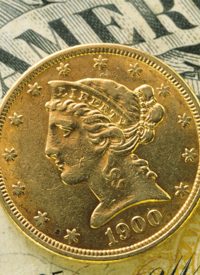
The first way is a “return to prior parity,” which would mean making a dollar redeemable in gold at $35 an ounce. Lewis points out that this would be impossible as it would entail a huge shrinkage in the money supply and a consequent depression. So option one is out.
The second way is to make a dollar redeemable in gold at a figure close to gold’s current price at between $1,500 and $1,700 an ounce. Lewis notes that this would also require a major restructuring — “a long price adjustment” — in his words, and “would probably cause a recession.” Not such a good option.
Lewis says there is a third option: Simply replace the currency with another one and make it redeemable in gold at some arbitrary value that the present gold supply would support. He points out that although the dollar is weak and getting weaker, few are ready for this. This option would apply only after the complete destruction of the dollar, something similar to what happened in the German Weimar Republic in the early 1920s. So that option isn’t feasible either. At least not yet.
But a gold standard is coming, ready or not, according to Lew Rockwell. He says,
Gold limits the flexibility and range of actions of central banks;
Under gold, a central bank can’t “stimulate growth and manage price stability;
Under gold, central banks can’t be the lender of last resort; and
Under gold, banks go belly-up rather than get bailed out.
The beauty of a true, 100-percent gold coin standard is that it puts control of money back into the hands of its owners, the citizens themselves. It becomes a normal business activity, like buying a pair of shoes or a tank of gas: Real value is exchanged for real value, not a paper promise. Gold fulfills all five of the essential elements for true money: It is liquid, it is stable, it is fungible (interchangeable), it is marketable, and it serves as a store of value.
The greatest advantage of gold is that it isn’t paper. Under the world’s paper money system, as Charles Scaliger noted in a previous The New American article,
Since Nixon killed the gold standard, the unemployment rate has averaged over 6% and we have suffered the three worst recessions since the end of World War II. The unemployment rate averaged 8.5% in 1975, almost 10% in 1982, and has been above 8.8% for more than two years, with little evidence of any improvement ahead.
This performance is horrendous compared to the post World War II gold standard era, which lasted from 1947 to 1970. During those 21 years of economic ups and downs, unemployment averaged less than 5% and never rose above 7%.
So the historical case for a gold standard is persuasive, but the paths back to convertibility appear to be limited and would take a minimum of five years. When the United States returned to a gold standard following the Civil War, the process took 14 years and involved much debate and several congressional acts to accomplish, including the Public Credit Act of 1869 and the Specie Payment Resumption Act of 1875. But once the citizens realized that their paper Greenbacks were now redeemable in gold, just for the asking, full restoration occurred swiftly.
In an article in the New York Times, James Grant, editor of Grant’s Interest Rate Observer, said that reinstitution of the gold standard would take time. He wrote,
The United States would first have to call an international monetary conference. A chastened Ben Bernanke would have to admit that, in fact, he cannot see into the future and needs the information that the convertibility feature of a gold dollar would impart.
That humbling chore completed, the delegates could get down to the technical work of proposing a rate of exchange between gold and the dollar … other countries … would then have to follow suit.
Grant’s view of the world precludes any recognition of a continuing vested interest in paper money by the Anglo-American establishment or the existence of the City of London, and so he misses the point entirely that at no time would Bernanke ever make such an admission.
Instead, Ron Paul’s bill, the “Free Competition in Currency Act of 2011,” or HR 1098, provides a much clearer, simpler, and shorter path to a gold dollar: Simply repeal the legal tender laws and allow citizens to choose from the resulting options the free market would immediately provide in competition with Federal Reserve Notes. Paul said, “This bill eliminates three of the major obstacles to the circulation of sound money: federal legal tender laws that force acceptance of Federal Reserve Notes; counterfeiting laws that serve no purpose other than to ban the creation of private commodity currencies; and tax laws that penalize the use of gold and silver as money.”
With enactment of Paul’s bill, the free market would generate alternative currencies for people to choose from, backed by silver or gold or perhaps even maple syrup. In the free competition of the market, Federal Reserve Notes would very quickly be relegated to museum pieces, an odd historical relic and reminder of how close the American people came to losing their freedom.



